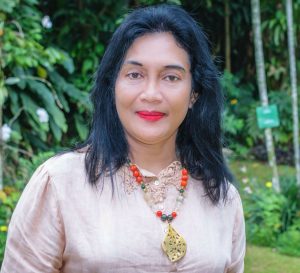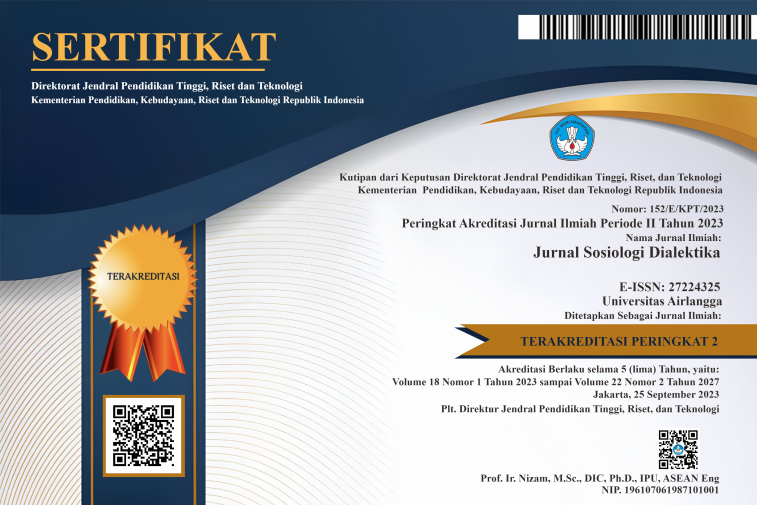The other space of social media: Concept study of heterotopia on Instagram
Downloads
Technological developments in society are separate space into two forms, real space and virtual space. The two meet each other when either individuals or communities use virtual space. Foucault described space to be three forms: dystopia, utopia, and heterotopia. This article aims to explain Instagram as virtual space that intersects real space, forming other spaces in the process. This article uses the perspective of the sociology of space and place while also using Foucault's theory of other space. This study used the qualitative research method with a discourse analysis approach. The finding of this article is that there are six heterotopia principles contained in Instagram's features. The results, Instagram forms other space beyond the activity of uploading photos or videos. Instagram as a real space becomes biased because of heterotopia. Individuals interpret Instagram differently as a place to share. On the contrary, when sharing activities, other individuals may use it for more than just sharing. Instagram has changed its space due to a shift in place use. Instagram can create other spaces besides its original function of uploading photos or videos through the other features on Instagram.
Abbott W, Donaghey J, Hare J & Hopkins PJ (2013) An Instagram is worth a thousand words: An industry panel and audience Q&A. Library Hi Tech News 30 (7):1-6.
Akmal HA & Coulton P (2018) Using heterotopias to characterise interactions in physical/digital spaces. Design Research Social Conference 1:269-278. DOI: doi:10.21606/dma.2017.348.
Alkandari AJ, Al-Hunaiyyan AA & Alhajri R (2016) The influence on Instagram use. Advances in Informartion Technology 7 (1):54–57.
Boerman SC (2019) The effects of the standardized instagram disclosure for micro- and meso-influencers. Computers in Human Behavior. doi:10.1016/j.chb.2019.09.015.
Carpenter JP, Morrison SA, Craft M & Lee M (2020) How and why are educators using Instagram? Teaching and Teacher Education 96:103149.
Castro DJV, Tvedebrink TDO & Albeniz IM (2018) The Heterotopias of Food: Spaces and (Other) Places in Food Practices. In: Bonacho R, de Sousa AP, Viegas C, Martins JP, Pires MJ & Estíªví£o SV (ed). Experiencing Food, Designing Dialogues. London: Taylor and Francis Group.
Damajani D (2008) Gejala ruang ketiga (thirdspace) di Kota Bandung: Paradoks dalam ruang publik urban kontemporer. Disertasi Program Doktor, Institut Teknologi Bandung, Bandung.
De Veirman M, Cauberghe V & Hudders L (2017) Marketing through Instagram influencers: The impact of number of followers and product divergence on brand attitude. International Journal of Advertising 36 (5):798-828.
Donath J & Boyd D (2004) Public displays of connection. BT Technology Journal 22 (4):71-82.
Feng X (2005) Internet and reality. Journal of China Youth College Political Sciences 2.
Foucault M (2008) Of Other Space. In: Dehaene M, Cauter L De (ed). Heterotopia and the City Public Space in a Postcivil Society. New York: Routledge.
Foucault M (2012) Arkeologi Pengetahuan. Yogyakarta: IRCISOD.
Gee JP (2005) An Introduction to Discourse Analysis: Theory and Method. New York: Routledge.
Hadi A (2018) Bridging Indonesia's digital divide: Rural-urban linkages? Jurnal Ilmu Sosial dan Ilmu Politik 22 (1):17-33.
Hu Y, Manikonda L & Kambhampati S (2014) What we Instagram: A first analysis of Instagram photo content and user types. In: Proceedings of The Eighth International AAAI Conference on Weblogs and Social Media. Michigan, 595-598.
Huang YT & Su SF (2018) Motives for Instagram use and topics of interest among young adults. Future Internet 10 (77):1-12.
Jordan B (2009) Blurring boundaries: The "real” and the "virtual” in hybrid spaces. Human Organization 68 (2):181-193.
Karimkhani C, Connett J, Boyers L, Quest T & Dellavalle RP (2014) Dermatology on Instagram. Dermatol Online Journal 20 (7):1-6.
Kawulich BB (2005) Participant observation as a data collection method. Forum: Qualitative Social Research 6 (2):1-28.
Khamis S, Ang L &Welling R (2017) Self-branding, ‘micro-celebrity' and the rise of social media influencers. Celebrity Studies 8 (2):191-208.
Kusuma K (2018) Activities of the cyber public relations of o chanel TV in promoting their company on the Instagram social media. American Journal Humanities Social Sciences Research 2 (9):50-56.
Lalancette M & Raynauld V (2017) The power of political image: Justin Trudeau, Instagram, and celebrity politics. American Behavioral Scientist 63 (7):888-924.
Lee KS & Wei H (2020) Social media as Heterotopia: Applying Foucault's concept of heterotopia to analyze interventions in social media as a networked public. Archives of Design Research 33 (2):5-17.
Litt E & Hargittai E (2016) The imagined audience on social network sites. Social Media + Society 2 (1):1-12.
Ljungberg E (2020) Media practices in the making of an "other space”: Communicating inclusion, exclusion, and belonging in a controversial heterotopia. New Media & Society 22 (12):2166-2182.
Lord B (2006) Foucault's museum: Difference, representation, and genealogy. Museum and society 4 (1):11-14.
Mahendra B (2017) Eksistensi sosial remaja dalam Instagram (sebuah perspektif komunikasi). Jurnal Visi Komunikasi 16 (1):151-160.
Marwick AE & Boyd D (2011) I tweet honestly, I tweet passionately: Twitter users, context collapse, and the imagined audience. New Media & Society 13 (1):114-133.
Moleong LJ (2003) Metode Penelitian Kualitatif. Bandung: CV Remaja Rosdakarya.
Monita R (2010) Heterotopia pada Ruang Keseharian Studi Kasus: Plaza Indonesia. University of Indonesia.
Papacharissi Z (2002) The presentation of self in virtual life: Characteristics of personal home pages. Journalism & Mass Communication Quarterly 79 (3):643-660.
Pradhana TA (2019) Self Presenting pada Media Sosial Instagram dalam Tinjauan Teori Dramaturgi Erving Goffman (Studi pada Mahasiswa UIN Sunan Ampel Surabaya). Tesis, UIN Sunan Ampel, Surabaya.
Rymarczuk R & Derksen M (2014) Different spaces: Exploring Facebook as heterotopia. First Monday 19 (6).
Salomon D (2013) Moving on from Facebook: Using Instagram to connect with undergraduates and engage in teaching and learning. ACRL TechConnect 74 (8):408-412.
Scolere L (2019) Brand yourself, design your future: Portfolio-building in the social media age. New Media & Society 21 (9):1891-1909.
Sudrajat I (2012) Conceptualizing a framework for research on place in Indonesia. In: The First International Seminar on Place Making and Identity, Rethinking Urban Approaches to Built Environment, 26-27 September 2012, Tangerang. Indonesia: The First International Seminar on Place Making and Identity, Rethinking Urban Approaches to Built Environment.
Topinka RJ (2010) Foucault, Borges, heterotopia: Producing knowledge in other spaces. Foucault Studies 9 (1):54-70.
Tuan YF (1977) Space and Place: The Perspective of Experience. Minneapolis, MN: University of Minnesota Press.
van Dijk JAG (2014) The evolution of the digital divide: The digital divide turns into inequality of skills and usage. New Media & Society 16 (3):507-526.
von Wachenfeldt P (2021) The mediation of luxury brands in digital storytelling. Fashion Theory 25 (1):99-118.
Warschauer M (2003) Technology and Social Inclusion: Rethinking the Digital Divide. Cambridge: MIT Press.
Woodward I (2007) Understanding Material Culture. London: Sage Publications.
Zhao X, Salehi N, Naranjit S, Alwaalan S, Voida S & Cosley D (2013) The many faces of Facebook: Experiencing social media as performance, exhibition, and personal archive. In: Proceedings of the SIGCHI Conference on Human Factors in Computing Systems. DOI: 10.1145/2470654.2470656.
Zulli D (2018) Capitalizing on the look: Insights into the glance, attention economy, and Instagram. Critical Studies in Media Communication 35 (2):137-150.
1. Copyright of this journal is possession of Editorial Board and Journal Manager, by the knowledge of author, whilst the moral right of the publication belongs to the author.
2. Legal formal aspect of journal publication accessibility refers to Creative Commons Attribution-NonCommercial-ShareAlike (CC BY-NC-SA), implies that publication can be used for non-commercial purposes in its original form (cannot be modified).
3. Every publications (printed/electronic) are open access for educational purposes, research, and library. Other that the aims mentioned above, editorial board is not responsible for copyright violation.















